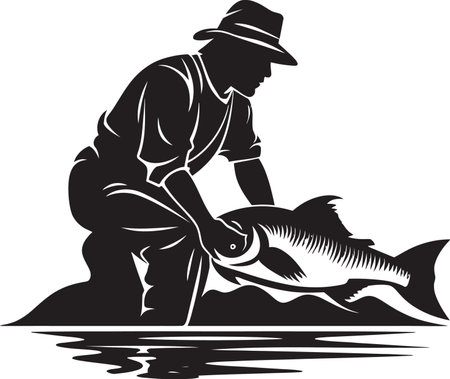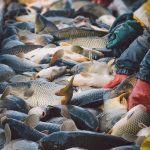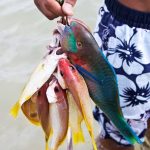1. Introduction to Trout Fishing in America
Trout fishing is more than just a hobby in the United States—its a beloved outdoor tradition that brings together anglers of all ages and backgrounds. Whether youre casting a line in a high mountain stream or drifting along a cool river, trout fishing offers both relaxation and excitement. From the East Coast to the West, trout fishing has deep roots in American culture and plays a big role in local economies, tourism, and conservation efforts.
The Popularity of Trout Fishing
Across the U.S., trout fishing is one of the most popular forms of freshwater angling. Millions of Americans take to the water every year in search of these beautiful and challenging fish. Trout are known for their elusive nature, making them a favorite target for those who enjoy both skill-based fishing and scenic outdoor adventures.
Regional Significance
Different regions in the U.S. offer unique trout fishing experiences. In the Rocky Mountains, cold alpine streams provide ideal habitats for native species like cutthroat and brook trout. In the Northeast, anglers often head to forested rivers to catch brook trout, while the Midwest is home to spring-fed creeks perfect for brown trout. Out West, especially in states like Montana and Colorado, fly fishing for rainbow trout is almost a way of life.
Common Trout Species in America
While there are several types of trout found across the country, three species stand out as favorites among anglers: rainbow trout, brook trout, and brown trout. Each has its own characteristics and preferred habitats, which makes identifying them an important part of being a successful angler.
Overview of Common Trout Species
| Species | Appearance | Native Range | Preferred Habitat |
|---|---|---|---|
| Rainbow Trout | Silvery body with pinkish-red stripe along sides; black spots on back and fins | Western North America | Cold rivers and lakes with clear water |
| Brook Trout | Dark green with light marbling on back; red belly (especially in males) | Eastern U.S. | Cool, shaded mountain streams and small creeks |
| Brown Trout | Golden-brown with black and red spots along sides | Introduced from Europe; now widespread across U.S. | Larger rivers, lakes, and spring-fed streams |
This guide will help you not only identify these beautiful fish but also understand where to find them and how to target them effectively. Whether youre just getting started or looking to sharpen your skills, learning about the culture and species of American trout fishing is the first step toward an unforgettable experience on the water.
2. Understanding Trout Species: Rainbow, Brook, and Brown
If youre heading out to fish for trout in America, its essential to know what youre looking for. The three most popular trout species—Rainbow, Brook, and Brown—are prized by anglers across the country for their beauty, fight, and availability. Each has its own unique traits that make them special. Let’s break down what makes these trout different in terms of appearance, behavior, and where they like to live.
Rainbow Trout
Rainbow Trout are one of the most recognizable trout species in North America. Theyre a favorite among fly fishers and beginners alike because theyre widely stocked and often more aggressive feeders than other species.
Physical Characteristics
- Colorful pink to reddish stripe running along each side
- Black spots on their back, fins, and tail
- Silvery body with a white belly
Behavior
Rainbow Trout are active swimmers and tend to stay in fast-moving waters like rivers and streams. They’re also known for strong fights when hooked, which adds to their appeal.
Natural Habitat
You’ll find Rainbow Trout in cold-water environments such as mountain streams, rivers, and clear lakes. Theyre commonly found throughout the western United States but have been introduced in many other states as well.
Brook Trout
Brook Trout are actually part of the char family and are native to eastern North America. They’re smaller than Rainbows or Browns but are admired for their vivid colors and are often considered the most beautiful trout.
Physical Characteristics
- Dark green to brown body with marbled patterns (called vermiculations)
- Red spots surrounded by blue halos along their sides
- Bright orange lower fins with white edges
Behavior
Brook Trout prefer cooler waters than Rainbows or Browns. They are more sensitive to pollution and water temperature changes, making them indicators of healthy aquatic ecosystems.
Natural Habitat
You’ll mostly find Brook Trout in small, cold headwater streams in the Northeast and Appalachian regions. They can also be found in high-elevation lakes across the U.S.
Brown Trout
Originally from Europe, Brown Trout were introduced to American waters in the late 1800s. Theyre now widespread and known for their elusive nature and challenging behavior.
Physical Characteristics
- Golden-brown body with dark spots surrounded by lighter halos
- Larger individuals may have a more yellowish belly
- No spotting on the tail (unlike Rainbows)
Behavior
Browns are more cautious than Rainbows or Brooks. They often feed at night or during low-light hours and tend to hide under cover during daylight.
Natural Habitat
You’ll find Brown Trout in both cool rivers and large lakes across much of the U.S., especially in the Midwest and Northeast. They adapt well to various environments but prefer deeper pools with structure like logs or undercut banks.
Trout Species Comparison Chart
| Species | Main Colors & Markings | Common Habitats | Behavior Traits |
|---|---|---|---|
| Rainbow Trout | Silvery body with pink/red lateral stripe; black spots all over body & tail | Crisp mountain streams, rivers, stocked lakes (nationwide) | Aggressive feeders; active during daylight; great fighters when hooked |
| Brook Trout | Green/brown with worm-like markings; red spots with blue halos; orange belly & fins edged in white | Cold headwater streams & high-elevation lakes (Northeast & Appalachians) | Sensitive to water quality; smaller size; prefer colder temps |
| Brown Trout | Tawny golden color with black & red spots; few or no tail spots; light halos around spots | Larger rivers & lakes (Midwest, Northeast); adaptable waters with structure cover | Cautious & smart; often feed at night; harder to catch during daytime hours |
No matter which species you’re targeting on your next fishing trip, knowing how to tell them apart helps you fish smarter—and better appreciate the diversity of trout found across America’s waterways.

3. Where to Find Trout: Top U.S. Fishing Locations
If youre looking to hook a rainbow, brook, or brown trout, knowing where to fish is half the battle. Across the United States, from mountain streams to spring-fed tailwaters, there are countless amazing places to cast a line. Heres a guide to some of the best trout fishing spots in America that every angler should know.
🗻 Rocky Mountains: Western Trout Paradise
The Rocky Mountains offer some of the most iconic trout waters in the country. Cold, clear rivers and high-altitude lakes make this region a favorite for both fly and spin anglers.
Top Spots in the Rockies:
| Location | State | Main Trout Species |
|---|---|---|
| Madison River | Montana | Browns, Rainbows |
| South Platte River (Deckers & Cheesman Canyon) | Colorado | Browns, Rainbows |
| Green River (below Flaming Gorge Dam) | Utah | Browns, Rainbows |
🌲 The Appalachian Region: Eastern Charm and Wild Brookies
The Appalachians stretch from New York down to Georgia and are home to many small streams filled with wild brook trout—Americas only native trout east of the Mississippi.
Top Spots in the Appalachians:
| Location | State | Main Trout Species |
|---|---|---|
| Savage River | Maryland | Browns, Brookies |
| Sugar Creek | Pennsylvania | Browns, Rainbows |
| Nantahala River | North Carolina | Browns, Rainbows, Brookies |
💧 Famous Tailwaters: Year-Round Trophy Trout Action
Tailwater fisheries—rivers flowing below dams—offer consistent water temperatures and flows, making them perfect for growing big trout. These spots are often open year-round and provide excellent fishing even in winter.
Notable Tailwater Destinations:
| Name | State | Main Trout Species |
|---|---|---|
| Norfork Tailwater (North Fork River) | Arkansas | Browns, Rainbows, Brookies, Cutthroats |
| Tennessee’s South Holston River | Tennessee | Browns, Rainbows |
| Bighorn River (below Yellowtail Dam) | Montana | Browns, Rainbows |
Trouble Deciding Where to Go?
If youre just starting out or planning your next trip, think about what kind of experience you want—remote mountain stream or easy-access tailwater? Do you want to chase wild brook trout or target trophy browns? No matter your style, theres a perfect spot for you somewhere across Americas diverse trout waters.
This guide is just scratching the surface. Local fly shops and state fish & wildlife agencies are great resources for up-to-date reports and regulations. Happy fishing!
4. Essential Gear and Techniques for Trout Fishing
If you want to catch more trout—whether its rainbow, brook, or brown—having the right gear and knowing how to use it is key. In this section, we’ll cover the basic equipment every angler should have and explore popular techniques like fly fishing, spinning, and bait fishing. Whether youre fishing a mountain stream or a stocked lake, this guide will help you get started with confidence.
Basic Trout Fishing Gear
Before you hit the water, make sure you have the essentials. Heres a quick breakdown of what youll need:
| Gear | Description | Recommended Use |
|---|---|---|
| Rod | Light to ultralight spinning rod (56″–7) or fly rod (3–6 weight) | All types of trout fishing depending on style |
| Reel | Spinning reel or fly reel to match your rod | Smooth drag is essential for fighting trout |
| Line | 4–8 lb test monofilament (spinning) or floating fly line | Lighter lines are better for clear water and wary fish |
| Lures & Flies | Spinners, spoons, soft plastics; dry flies, nymphs, streamers | Choose based on water conditions and target species |
| Bait | Worms, salmon eggs, PowerBait | Effective for beginners and stocked trout waters |
Popular Trout Fishing Techniques
Fly Fishing
This classic technique is especially popular in streams and rivers where trout feed on insects. You’ll need a fly rod, matching reel, floating line, and a selection of flies that mimic local bugs. Dry flies work well when trout are rising to the surface, while nymphs and streamers are good for deeper water.
Spinning
A favorite method for both beginners and seasoned anglers. Lightweight spinning rods paired with small spinners like Panther Martins or Rooster Tails can be deadly in both moving and still water. Cast upstream in rivers or near structure in lakes for best results.
Bait Fishing
If youre just getting started or fishing stocked ponds and lakes, bait fishing is an easy and effective option. Use natural baits like worms or salmon eggs on a small hook with light line. Add a split shot weight to keep your bait near the bottom where trout often feed.
Tip:
Trout are sensitive to pressure and noise. Keep your approach stealthy—wear neutral colors, wade quietly, and cast carefully to avoid spooking them.
Matching Gear to Trout Species
| Species | Best Gear Setup | Preferred Technique |
|---|---|---|
| Rainbow Trout | Ultralight spinning rod with spinners or PowerBait | Bait fishing or spinning in lakes and rivers |
| Brook Trout | Short fly rod (3–4 wt) with dry flies or nymphs | Fly fishing in small streams or backcountry creeks |
| Brown Trout | Medium-light spinning rod with jerkbaits or streamers | Casting near cover during low-light hours |
No matter which method you choose, having the right gear makes all the difference. Practice casting at home before you go out, learn about local insect hatches if youre fly fishing, and always check your knots before hitting the water. With some preparation—and patience—you’ll be well on your way to landing beautiful American trout.
5. Conservation and Responsible Angling Practices
Trout fishing in America is more than just a sport—its a tradition that depends on clean water, healthy ecosystems, and responsible anglers. Whether youre after rainbow, brook, or brown trout, understanding how to fish sustainably ensures these beautiful species are around for generations to come.
Catch-and-Release: Doing It Right
Catching trout can be exciting, but releasing them properly is key to their survival. Follow these simple steps to give released fish the best chance:
| Best Practice | Why It Matters |
|---|---|
| Use barbless hooks | Makes unhooking easier and reduces injury to the fish |
| Wet your hands before handling | Protects the fish’s slime coat which helps prevent disease |
| Keep the fish in the water as much as possible | Minimizes stress and increases survival rate |
| Use rubber landing nets | Less damaging than nylon nets to fins and scales |
Sustainable Fishing Tips
Sustainable fishing means enjoying the sport without harming the ecosystem. Heres how you can do your part:
- Follow local regulations: Always check size limits, bag limits, and seasonal rules.
- Avoid spawning areas: Trout are especially vulnerable during spawning season. Learn to identify and avoid redds (spawning beds).
- Pack out all trash: Even biodegradable items like food scraps can affect local wildlife.
- Respect private property: Always ask permission before fishing on private land.
Helping Preserve Trout Habitat
Your actions off the water matter too. Protecting trout habitat keeps rivers and lakes clean for both fish and people:
- Support conservation groups: Organizations like Trout Unlimited work hard to restore streams and protect watersheds.
- Volunteer for stream clean-ups: These events are great for giving back and meeting fellow anglers.
- Avoid using harmful chemicals at home: Fertilizers and pesticides can run off into waterways.
- Promote native vegetation near streams: Plants help prevent erosion and keep water temperatures cool for trout.
The Role of Every Angler
No matter where you fish—from Appalachian creeks full of brook trout to Western rivers teeming with rainbows—your behavior makes a difference. Being a responsible angler means protecting what you love, so future generations can enjoy the thrill of trout fishing across America.


